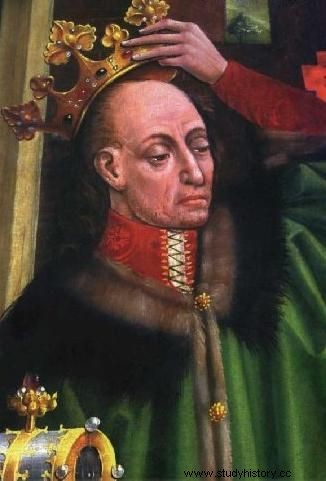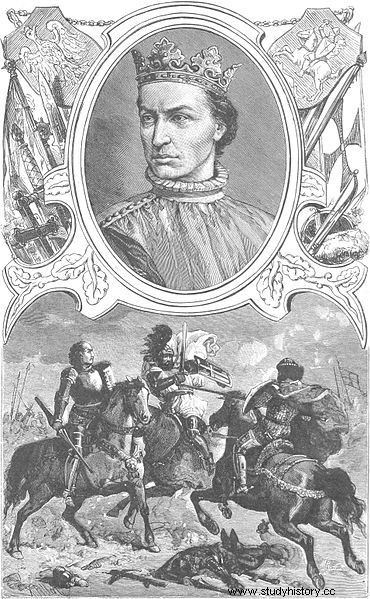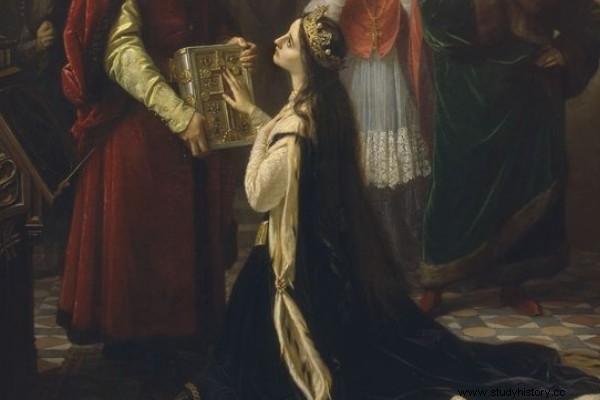Jadwiga liked to eat well - white bread was baked especially for her and salmon were brought to Krakow from abroad. The queen was also a drinker - unlike her husband, who not only ate little and did not pay much attention to the contents of his plate, but also preferred milk to alcohol. But when he liked something, he could completely lose moderation ...
When there was serious talk about the candidacy of Władysław Jagiełło for a husband for Jadwiga Andegaweńska, gossip began to boom at the Polish court. The Habsburgs, along with the Teutonic Knights, spread almost unbelievable stories that the ruler lived in trees and had a body thickly covered with fur. In addition, he was supposed to be cruel, deceitful and uncouth - also at the table. And he would mainly eat what he hunted with his own hands.
From Lithuanian land to Poland
Of course, most of these stories turned out to be bogus, although Jagiełło actually postponed hunting over court ceremonies and entertainment, and sometimes provided venison to Wawel kitchens with his "spoils" from hunting.

Portrait of Władysław Jagiełło, fragment of the Gothic altar from the Wawel Cathedral, ca. 1475-1480
However, he was not a barbarian from "wild" Lithuania. Every day he ate - for those times - very normally, although undoubtedly moving to the Vistula in terms of cuisine must have been a challenge for him. Wika Filipowicz comments:
He liked Polish cuisine, he ate with appetite roulades, then called "suropieki", he also liked "flaky", soups, roasts, guts and stews. However, the best thing he saw on the table was dishes straight from his native Lithuania.
On his order, a local variety of parsnips was even brought to Krakow, from which his chef, Mikołaj Koza, had borscht (this was the term used to describe any sour soup made from pickled plant parts - not necessarily beetroots) for the royal table.
Apart from the Lithuanian parsnip tincture, Jagiełło relieved his longing for his homeland with the help of local delicacies such as goose offal stew, oat jelly, stewed turnips or "pirogi" stuffed with meat or vegetables. One of his favorite dishes was cheese dumplings cooked in butter (somewhat similar to today's lazy ones) - which his wife looked at with open disgust and reportedly refused to even touch them.

Władysław Jagiełło in the series Images of Polish princes and kings by Ksawery Pillati from 1888.
Besides, the culinary tastes of the royal couple did not only differ in this matter. While Jadwiga ate luxurious white flour bread, Władysław liked wholemeal bread with bran. He also avoided alcohol, while his wife was a famous beer drinker. Although in this respect, Jagiełło won practical reasons - fearing poisoning (and poison is easier to "smuggle" in wine or beer than in pure water), he avoided alcoholic beverages just in case. As Wika Filipowicz writes:
He was abstinent. He drank mainly spring water (well water or river water was usually polluted and was considered - in this situation quite rightly - unhealthy), reportedly also imported from Lithuania. Only from the really big bell he allowed himself a little wine diluted with it.
He also did not despise milk, sweet and sour, for which he did not find followers. It was not a very popular drink, it was used mostly for whitening dishes, and at most children were given it to drink until they started drinking beer.
The Forbidden Fruit
Like a child, the ruler also had a marked weakness for sweetness and fruit. Although, as Jan Długosz argued, he avoided apples as eagerly as he avoided alcohol (but this is not confirmed in the accounts of Jagiełło's Wawel cuisine, to which "heavenly" fruit was ordered in bulk).
But he certainly couldn't deny himself a sweet pear dessert which - as the chronicler emphasizes:"he often ate in secret". But why did the king have to hide from it anyway? There were religious considerations and ... medieval stereotypes of masculinity. As reported by Wika Filipowicz:
In the Middle Ages, the pear tree was considered a symbol of the Virgin Mary due to the pristine whiteness of its flowers, and in addition, the shape of the fruit and its delicate taste meant that it was attributed to femininity, so men eating them could be accused of being effeminate.
On the other hand, Władysław could eat blueberries, cherries, plums, grapes and melons without hesitating. Not only fresh - the king also loved dried and honey-fried fruits. He also did not disdain candy (although the medieval ones did not resemble modern ones in any way - they were spicy and were used to refresh the breath).

The spouses' eating habits varied significantly
And after dessert? Jan Długosz reports that the king liked to sleep after a good meal. Especially if he overdid the number of dishes during the supper. And although not often (he approached the food very pragmatically and ate as much as he had to, usually not particularly caring about the contents of the plate - as long as it was not "spiced up" with poison, of course), he did occasionally indulge himself.
There were times when a dish tasted a bit too much for Jagiello - such as a freshly prepared buffalo heart, which in 1412 made the king attacked with "strong fever", after he ate it without moderation, and then came to the bathhouse before taking a nap. This type of "jumps" did not happen to him often. Jadwiga was much more willing to feast , used to sophisticated entertainment and court entertainment from an early age. Władysław had a slightly different vision of what entertainment worth a king should look like, and it consisted of hunting, naps and ... listening to the singing of nightingales!
Source:
The text is based on the book Wiki Filipowicz book At the table with the king. How was feasted at the royal court from Jagiełło to Elizabeth II , which has just been released by the Znak Horyzont publishing house.
